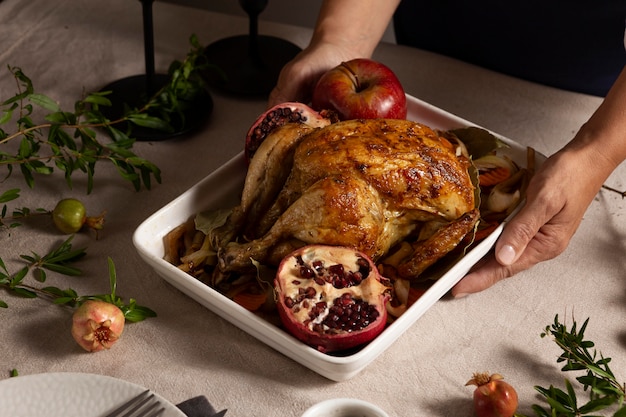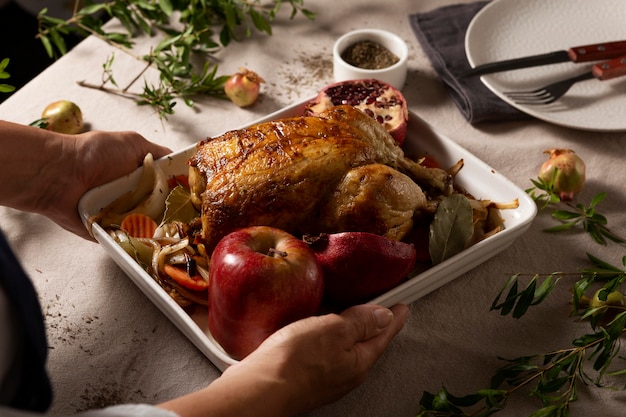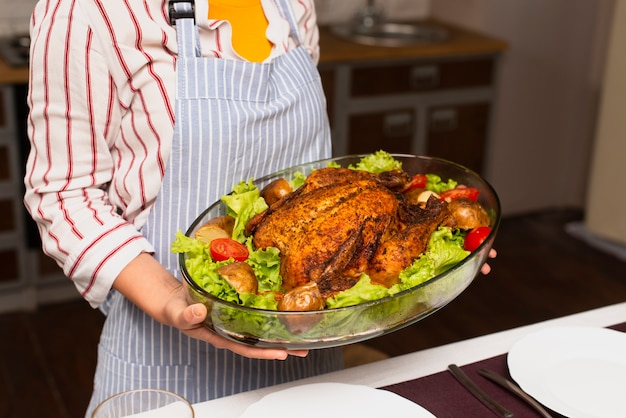Let's talk turkey, shall we? But not just any turkey - let's talk about roasting the perfect turkey, the kind that makes your mouth water and your family beg for seconds. Forget the stress of a traditional oven, because I'm going to let you in on a little secret: electric roasters are a game-changer.
For years, I was a traditional oven purist. I thought electric roasters were for the faint of heart, but after a few dry and disappointing turkey experiences, I finally decided to give them a try. And let me tell you, I haven't looked back. It's like a revelation! Juicy, flavorful turkey every time? Yes please!
This isn't just a dry, boring how-to guide, folks. We're going to dive into the nitty-gritty of electric roaster turkey, from choosing the right bird to mastering the perfect gravy, and everything in between. So, grab a cuppa, get comfy, and let's get this turkey roastin'!
(Part 1) Choosing the Right Turkey: Finding Your Perfect Bird

The first step to a delicious roast is choosing the right turkey. Forget those tiny birds for a dinner for two; we're talking roaster size, a bird that'll feed the whole family (and maybe even the neighbours!).
The Goldilocks Rule: Not Too Big, Not Too Small
Generally, a turkey weighing 12-14 pounds is ideal for a group of 8-10 people. But if you're hosting a thanksgiving feast or a Christmas gathering for a crowd, you might want to size up to a bigger bird.
Remember, a turkey that's too small for your roaster can lead to overcrowding, uneven cooking, and a potential mess. On the other hand, a turkey that's too big will have plenty of room to swim in its own juices.
A good rule of thumb is to choose a roaster that's at least 2-3 inches larger than your turkey.
Fresh or Frozen?
Now, the age-old debate: fresh or frozen? Honestly, it comes down to personal preference. I find that fresh turkeys tend to have a more intense flavor, but frozen turkeys are definitely more convenient, especially if you're planning ahead.
Just make sure you thaw the frozen bird properly. You can safely thaw a turkey in the fridge for 3-4 days, or you can submerge it in cold water (changing the water every 30 minutes) for 3-4 hours.
(Part 2) Getting Ready for the Roast: Brining, Seasoning, and More!

You've got your perfect bird, and your roaster is ready and waiting. Now it's time to get ready for the main event.
Brining: The Secret Weapon for juicy turkey
Brining is a bit of a controversial topic, but trust me, it makes a world of difference. It's like giving your turkey a spa treatment! Brining adds moisture and flavor to the turkey, resulting in incredibly tender, juicy meat.
Brine Basics
A basic brine is simply a mixture of salt, water, and sometimes sugar. You'll find countless brine recipes online, but I prefer a simple one:
1 cup kosher salt
1 cup sugar
1 gallon of water
Brining Time
The turkey should soak in the brine for 12-24 hours. Make sure the entire bird is submerged in the brine and keep it refrigerated.
Brine Alternatives
If you're not into the whole soaking thing, you can use a dry brine, which involves rubbing the turkey with a mixture of salt and herbs. It's a bit less time-consuming, but it doesn't provide the same level of moisture as a wet brine.
Preparing the Turkey: Pat, Season, and Add Moisture!
Now, it's time to get your hands dirty and prepare your turkey for its starring role.
Patting It Dry
Remove the turkey from the brine (if you used one) and pat it dry with paper towels. This will help the skin get nice and crispy.
Stuffing or No Stuffing?
The age-old debate! I personally don't stuff my turkey when using an electric roaster. Stuffing can cause the turkey to cook unevenly and can increase the risk of foodborne illness. Instead, I roast the stuffing separately.
Seasoning: A Symphony of Flavors
Now for the fun part: seasoning! You can use a pre-made turkey seasoning blend, or unleash your creativity and create your own.
I like to rub the turkey with a blend of:
Salt
Pepper
Paprika
Garlic powder
Onion powder
Dried herbs like thyme, rosemary, or sage
Adding Moisture: Unlocking Juicy Potential
To ensure a truly succulent turkey, I like to add a little extra moisture to the roaster. You can do this by:
Adding butter or olive oil to the bottom of the roaster.
Placing a few slices of bacon or onions around the turkey. These add flavor and moisture as they cook.
Adding a cup of chicken broth or water to the roaster. This helps create steam and keeps the turkey moist.
(Part 3) Roasting the Turkey: The Magic Begins!

This is the moment we've all been waiting for! The stage is set, the turkey is prepped, and it's time to unleash the power of the electric roaster.
Getting the Roaster Ready
First things first, preheat your electric roaster according to the manufacturer's instructions. This usually takes about 15-20 minutes.
Placing the Turkey
Place the turkey in the roaster breast side up. Make sure it fits comfortably but still has some room for air circulation around it. You don't want the turkey to be cramped!
roasting time: A Guide for Perfect Cooking
Roasting time will vary depending on the size of your turkey. However, a good starting point is about 3-4 hours for a 12-14 pound turkey.
Monitoring the Temperature: No Guesswork Allowed
Don't forget to use a meat thermometer! This is your best friend. You want to make sure the turkey is cooked to an internal temperature of 165°F (74°C) in the thickest part of the thigh.
Basting the Bird: Keeping it Moist and Delicious
Basting the turkey with the pan juices every hour or so is a good way to keep it moist and prevent it from drying out. Just spoon some of the juices over the turkey to keep it happy.
Resting Time: Letting the Juices Redistribute
Once the turkey is cooked, let it rest for at least 30 minutes before carving. This is crucial! It allows the juices to redistribute throughout the meat, resulting in a tender, flavorful turkey.
(Part 4) Gravy Time: The Finishing Touch
Now, this is where the real magic happens. Gravy is the crowning glory of any roast turkey, and it's easy to make with your electric roaster.
Making Gravy: Turning Pan Drippings into Deliciousness
While the turkey is resting, make the gravy. The drippings from the roaster are the key to a rich, flavorful gravy.
Deglazing the Pan: Unlocking the Flavor
Pour off any excess fat from the roaster. Then, add a couple of tablespoons of flour to the pan and whisk it around. This process is called "deglazing" the pan, and it helps to release all the flavor trapped in the drippings.
Adding Liquids: Choosing Your Base
Next, add the liquid of your choice to the pan and whisk it all together. You can use chicken broth, water, or even wine. The choice is yours!
Simmering and Seasoning: Bringing it All Together
Simmer the gravy over low heat for about 5 minutes, stirring occasionally. Season to taste with salt and pepper.
Tips for Perfect Gravy
Don't overcook the gravy. It should be smooth and slightly thickened.
Strain the gravy to remove any large pieces of turkey or fat.
Keep the gravy warm while you're carving the turkey.
(Part 5) Carving the Turkey: A Skill for Every Cook
Time to show off your carving skills!
Carving Tips
Use a sharp carving knife. A dull knife will tear the turkey and make carving difficult.
Start by carving the legs and thighs. Cut along the joint where the leg meets the body, then pull the leg away from the turkey.
Carve the breast meat in thin slices, going against the grain. This ensures tender, flavorful slices.
Remove the wing. Cut the wing at the joint where it connects to the body.
(Part 6) Serving the Feast: A Celebration of Flavor
Your turkey is cooked, your gravy is simmering, and it's time to celebrate your culinary triumph.
Creating a Festive Table
Make sure to set a festive table! Use a nice tablecloth, your best china, and some festive decorations.
Serving the Turkey
Arrange the carved turkey on a platter and surround it with side dishes. Place the gravy in a gravy boat or a pitcher.
Enjoy the Feast!
Now it's time to enjoy the fruits of your labor. Relax, gather your loved ones, and savor the delicious turkey you've created.
(Part 7) Leftover Turkey: Don't Let It Go to Waste!
The turkey may be the star of the show, but don't forget about the leftover turkey! There are countless ways to use it.
Leftover Turkey Dishes
turkey sandwiches. A classic for a reason!
turkey salad. Combine leftover turkey with mayonnaise, celery, onion, and your favorite spices.
turkey soup. Add leftover turkey to your favorite soup recipe.
turkey pot pie. A comforting and delicious way to use up leftover turkey.
Turkey enchiladas. A fun and flavorful way to use leftover turkey.
(Part 8) Electric Roaster vs. Traditional Oven: Making the Right Choice
So, what's the verdict? Electric roaster or traditional oven?
Advantages of Electric Roasters
Even cooking. Electric roasters provide consistent heat, resulting in a more evenly cooked turkey.
Less drying out. The moist environment of an electric roaster helps to prevent the turkey from drying out.
Easier cleanup. Electric roasters are generally easier to clean than traditional ovens.
Advantages of Traditional Ovens
More versatility. Traditional ovens can be used for a wider variety of cooking tasks.
Greater temperature control. Traditional ovens offer more precise temperature control.
(Part 9) Electric Roaster Turkey: A Final Word
roasting a turkey in an electric roaster is a breeze, and the results are incredible.
Embrace the Simplicity
Forget about the stress of a traditional oven! An electric roaster makes roasting a turkey a simple and enjoyable experience.
Embrace the Flavour
A perfectly cooked turkey, bursting with flavor, is waiting to be enjoyed.
Embrace the Joy
Gather your loved ones, share the feast, and make memories that will last a lifetime.
FAQs
1. Can I use an electric roaster to roast other meats?
Absolutely! Electric roasters are great for roasting all sorts of meats, including chicken, ham, and pork loin.
2. How do I know if my electric roaster is big enough?
The roaster should be at least 2-3 inches larger than your turkey. If it's too small, the turkey won't cook evenly, and if it's too big, the turkey will swim in its own juices.
3. Can I use a frozen turkey in an electric roaster?
Yes, but you'll need to thaw it properly first. You can thaw a frozen turkey in the fridge for 3-4 days, or submerge it in cold water (changing the water every 30 minutes) for 3-4 hours.
4. What if the turkey isn't cooked through?
If the turkey isn't cooked through after the recommended roasting time, continue cooking it in 30-minute increments, checking the temperature with a meat thermometer each time.
5. Can I use a turkey roasting bag in an electric roaster?
While some people use turkey roasting bags in electric roasters, it's generally not recommended. The bag can trap moisture and steam, which can make the turkey cook unevenly.
Everyone is watching

How to Cook Frozen Lobster Tails Perfectly: A Step-by-Step Guide
RecipesLobster. Just the word conjures up images of lavish meals, special occasions, and a taste of luxury. But let's...

Pigs in a Blanket Cooking Time: How Long to Bake for Perfect Results
RecipesAh, pigs in a blanket. Just the name conjures up images of those delightful little parcels of crispy pastry en...

Pork Fillet Cooking Time: How Long to Cook It Perfectly
RecipesPork fillet, or tenderloin as it's sometimes called, is a real favourite in our house. It's so versatile, and...

The Ultimate Guide to Tender, Juicy Pulled Pork
RecipesRight, let's talk pulled pork. It's one of those dishes that just screams "comfort food," doesn't it? I mean...

The Ultimate Guide to Cooking Sweet Potatoes: From Roasting to Mashing
RecipesSweet potatoes. Just the name conjures up images of warm, comforting dishes, bursts of vibrant color, and a to...
